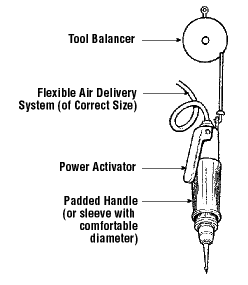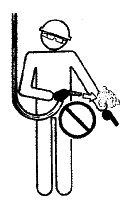Powered Hand Tools - Pneumatic Tools - Basic Safety
On this page
What are pneumatic tools?
Back to topPneumatic tools are powered by compressed air. Common types of air-powered hand tools used in industry include:
- Buffers
- Nailing and stapling guns
- Grinders
- Drills
- Jackhammers
- Chipping hammers
- Riveting guns
- Sanders
- Wrenches
These tools are versatile and efficient, but they require proper handling and maintenance to ensure safe operation.
How do you use pneumatic tools safely?
Back to top- Review and understand the manufacturer's instructions before using a tool.
- Wear safety glasses or goggles, or a face shield (with safety glasses or goggles), and, where necessary, protective footwear and hearing protection.
- Use low-vibration tools, or tools with an auto-balance system or anti-vibration handle. Vibration can cause changes in tendons, muscles, bones and joints, and can affect the nervous system, including the development of Raynaud's Phenomenon.
- Post warning signs where pneumatic tools are used.
- Set up screens or shields in areas where nearby workers may be exposed to flying fragments, chips, dust, and excessive noise.
- Ensure that the compressed air supplied to the tool is clean and dry. Dust, moisture, and corrosive fumes can damage a tool.
- Use an in-line regulator filter and lubricator to increase tool life.
- Keep tools clean and lubricated.
- Maintain tools according to the manufacturer's instructions.
- Use only the attachments that the manufacturer recommends for the tools you are using.
- Install a safety cable or a whip check to prevent uncontrolled hose movement if a connection or coupling fails.
- Prevent hands, feet, or body from being in the path of the tool in case the machine slips or the tool breaks.
- Support heavy tools with counter-balances or tool balancers wherever possible to reduce physical fatigue.
- Keep your hands and fingers warm̛ when using vibrating tools. Wear cold-resistant gloves or install an insulating sleeve on the tool handle if it is made of metal.

How should you handle air hoses?
Back to top- Use the proper hose and fittings of the correct diameter and rating for the tool.
- Use hoses designed to resist abrasion, cutting, crushing, and failure from continuous flexing.
- Choose air-supply hoses that have a minimum working pressure rating of 1035 kPa (150 psig) or 150% of the maximum pressure produced in the system, whichever is higher.
- Check hoses regularly for cuts, bulges, abrasions, or other damage. Tag and replace defective hoses immediately.
- Blow out the air line before connecting a tool. Hold the hose firmly and direct airflow away from yourself and others.
- Make sure that hose connections fit properly and are equipped with a mechanical means of securing the connection (e.g., chain, wire, or positive locking device).
- Install pressure-release quick disconnects instead of disengagement-type connectors. Attach the male end of the connector to the tool, NOT the hose.
- Do not operate the tool at a pressure above the manufacturer's rating.
- Turn off the air pressure when the hose is not in use or when changing tools.
- Avoid creating trip hazards by laying hoses across walkways or leaving them curled underfoot.

What should you avoid when using compressed air?
Back to top- Do not use compressed air to blow debris or to clean dirt from clothes. Cleaning with compressed air is dangerous. See
Cleaning with Compressed Air for more information, including the laws that may apply. - Do not exceed the manufacturer's specified pressure rating for tools, hoses, or fittings.
- Do not carry a pneumatic tool by its hose.
- Do not direct compressed air at others.
- Do not operate without proper personal protective equipment, including eye and face protection, hearing protection, gloves, protective footwear, and respiratory protection, if necessary.
- Do not use compressed air near flammable materials, combustible dusts, or in areas where there is a risk of fire or explosion.
- Fact sheet last revised: 2025-08-25

